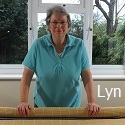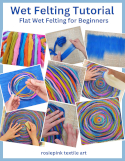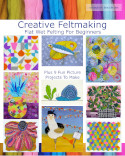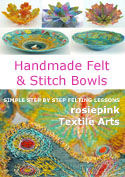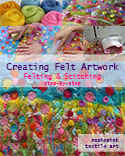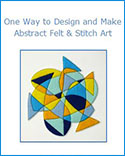We are often asked questions about felt-making techniques so here are some of those questions answered and some 'tips' for those who’ve just started having a go at wet-felt making and needle-felting.
First, a couple of notes about wool tops (or roving). Your wool should be stored and handled carefully. To felt wool, all that is required is moisture and agitation, so if your wool becomes damp and is handled roughly, it will soon become matted and hard to use.
To pull a tuft of wool from a ball of tops or roving, keep your hands about six inches apart and pull very slowly. If you hold the fibres too close to the point where you want them to part, and pull quickly, it will prove difficult.
Pulling the wool fibres apart gives soft edges that felt together smoothly. Cutting the wool with scissors gives a blunt edge that can be useful in some designs.
Wet-felting tips
Colour & Texture
Rather than just using the dyed wool straight out of the packet, try combining two or three colours together. Pull off one tuft of each colour then lay them one on top of the other. Grasp the ends and gently pull apart. Lay the two pieces one on top of the other and repeat until you get a pretty blend. Stop before it goes muddy!
Try including fancy yarn, silk tops or scraps of material into the top layer of your felt (lay your inclusions on the top layer of wool before you start to felt it.) Remember that manmade fibres will not felt – they have to be ‘trapped’ into the wool. If the fabric scrap is open weave, the wool will trap it quite easily and if the fancy yarn has a loose ply or is fluffy, again the wool will trap it easily – experiment to see what works. Some materials will need a few wool fibres laid over them to trap them into place.
Try embellishing with some hand or machine embroidery. When the felt is dry, place the wrong side onto a piece of calico, or stablisier fabric, then run some machine embroidery stitches over the right side – amazing what happens! The texture of the felt combined with the stitching can be quite magical.
You could also try needle-felting some detail onto your (dry) wet-felt or stitch on beads.
Does your finished felt look a bit lumpy?
Make several fine layers rather than a few thick ones. Try working with tepid water and don't reheat your work to hurry it along. Slow and gentle manipulation of the wool fibres (especially at the start of the felting process) will slow the fulling which results in a much smoother finish.
Is your wool sliding around and not felting?
Only have enough water to thoroughly wet the wool and get rid of any excess (you can use a sponge to mop it away or if the felt is beginning to hold together, you can roll it up and gently squeeze the water out). Slippage can be caused by using too much soap.
How do you know when it’s felted?
Use the ‘pinch test’. Pinch your thumb and index finger into your felt and if you can lift fibres away, then it’s not felted yet – you need to work it some more!
What is 'fulling'?
Fulling is the shrinking and hardening of felt.
Do you have trouble getting rid of the soap suds?
Soap is useful for getting your wool to absorb water (have you noticed how water-repellent the wool is?) but use too much and the wool just slips around instead of felting and it’s difficult to remove at the end. You can use any soap, but soap made from unrefined olive oil with no artificial colours or perfumes, is low sud and makes felting easier.
Why do some colours of wool felt easier than others?
Sorry, this remains a mystery to us. We have sometimes found reds and purples difficult to felt. They will felt in the end, they sometimes just need a bit more patience and extra rolling. Once your felt is holding its shape sometimes a dash of really hot water can help.
How can you replicate a piece of felt that turned out wonderfully?
It’s difficult to replicate a piece of felt exactly, but to get a similar result, make notes e.g. the colours of the wool used, how many layers, the size of the piece before felting and the size after (to determine shrinkage), what inclusions (fancy yarn or silk) you used etc. A photographic record will enhance your notes.
Are you happy with the final shape?
When you've finished your piece of felt, especially if you are making a 3D piece, you can change the shape quite dramatically by literally hitting it into shape. Use the bowl of a wooden spoon or your (soapy) hands or a palette knife and whack it into shape. If it’s a flat piece of felt, then you can carefully pull it into shape. You can also create frilly edges by pulling and teasing the felt.
The felt will keep whatever shape it dries in.
Needle felting tips
What’s the best way to learn to needle felt?
The best way is to just have a go! As with wet felt making you will find what methods and techniques work best for you. The basic principle is simple - by jabbing the barbed felting needle through your wool it gradually felts together by pulling fibres from below back up through the fibres on top. You will be making simple patterns and beads in no time.
Do I have to use a base material?
No, you can needle felt wool into any shape you want just by needling it on top of a dense foam pad or special needle felting brush.
Can I needle-felt onto (dry) wet-felt?
Yes. Needle-felting can be used to add details.
How do I know which needle to use?
For tough work (perhaps needle felting onto a heavy, closely woven fabric) you need a thick needle and for fine detail you need a thinner needle. The lower the number of the needle the thicker it is.
Needles have small barbs that catch fibres to push/pull and entangle them. They come in different shapes and sizes – triangular needles have fewer barbs than star needles.
For beginners, a 38 triangle is a good all-purpose needle to use and if you want a smoother finish, use a 40 triangle in the final stages.
How do I get a fine, delicate looking piece of needle felt?
Use a 40 triangle needle and work with fine, wispy layers of wool.
Don’t over felt – make it tight enough to hold but loose enough to be delicate.
Why do my needles keep breaking?
Felting needles can easily break – never bend your needle while felting. Always poke the needle straight into the wool, and pull it straight out again at the same angle.
Always work on a dense foam pad or special needle felting brush so that the needle has a soft landing!
My piece of needle felt has gone too hard!
The more you work on an area of wool, the more the fibres become tangled and dense therefore making it hard. When you are building up a pattern, try not to over felt the under-layers - just needle it enough to make it hold.
Is there an easy way to needlefelt shapes onto fabric?
A quick and easy way to do this is to felt inside a cookie cutter. Put your cookie cutter on to your fabric and then gently push 2 or 3 layers of teased out wool top into the cookie cutter. Now begin jabbing the needle around the inner edge of the cookie cutter and working inwards. You should get a nice crisp shape. This can work equally well with your own template cut from thick card.
How can I stop my felt sticking to the pad?
Every so often, carefully peel your needlefelt off the pad and needle the back a little before replacing on the pad.
I’ve made some petals to form a flower but I can’t needle felt them together!
When making pieces that will need joining together, always leave the area to be joined very loosely felted (or leave loose fibres hanging) so that the fibres get a chance to entangle at the join.
How can I make my needle felted flowers more attractive?
Sew a few seed beads onto them – not too many and be random with the placement of the beads.
 Follow us on Instagram
Follow us on Instagram

